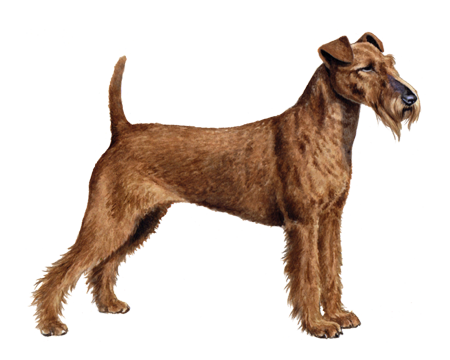
Wire Fox Terrier
Good-natured, playful, and feisty, the Wire Fox Terrier makes a great sidekick and companion. They are loving and affectionate with family and excellent with older children. Alert and fearless, Wire Fox Terriers also love chasing rats and foxes (hence the name).
Interested in discovering if your dog is a Wire Fox Terrier?
Check out Wisdom Panel's DNA tests.

Wire Fox Terrier Traits
General Appearance
Wire Fox Terriers have a generally happy, animated, and lively appearance.
Coat and Coloring
The Wire Fox Terrier's wiry coat is predominantly white with patches of black, tan, or combinations of black and tan. Solid white coats are also possible.
Distinctive Physical Traits
The Wire Fox Terrier has a dense but wiry coat that's ideally crinkly or slightly wavy.
Wire Fox Terrier Temperament
Wire Fox Terriers are determined dogs that always want to be on the go. Agile and energetic, these pups fit perfectly in an active family.
Typical of many terriers, the Wire Fox Terrier might not get along well with other dogs and loves to bark, dig, and chase wildlife. These tenacious dogs can also be challenging to distract once they're engaged in an activity.
True to their breed, Wire Fox Terriers have rambunctious personalities and great enthusiasm and courage. Despite their small size, these dogs are not couch potatoes—they are far too busy to sit on a lap.


Wire Fox Terrier History
The Wire Fox Terrier dates back to the 1800s. The breed descended from the now-extinct Rough-Coated Black-and-Tan Terrier of Wales, Derbyshire, and Durham. This ancestor assisted in fox hunts by tracking foxes, guiding the hunters, and then driving the foxes from their dens.
Wire Fox Terriers grew popular during the 1930s after being featured in the popular "Thin Man" series of movies and in "The Adventures of Tintin" comic strip. But in later years, the breed's population decreased as more people moved from the country into cities.
The American Kennel Club recognized the Wire Fox Terrier in 1885. But it wasn't until 1985 that the club formally recognized it as separate from the Smooth Fox Terrier.
Wire Fox Terrier Care
Nutrition
The Wire Fox Terrier needs high-quality, age-appropriate dog food. All dogs run the risk of obesity if they eat too many calories. So, keep an eye on how much your Wire Fox Terrier eats, and reduce portions if your pup gains weight. Also, remember that giving too many treats in addition to regular meals can contribute to obesity.
Grooming
The grooming needs of Wire Fox Terriers can vary. The coats of show dogs should be hand-stripped. But average pets can have their coats clipped, which requires much less effort. Either way, this breed requires regular brushing to avoid matting.
Monthly nail trims are a great habit to get into, along with weekly ear checks for wax buildup and debris.
Exercise
Wire Fox Terriers have an insatiable amount of energy. They are up for almost anything, whether it's taking a long walk, chasing a ball, or playing games in a (fenced) yard. Wire Fox Terriers also enjoy dog sports such as agility, flyball, tracking, and earthdog trials.
You should leash your Wire Fox Terrier whenever they're in an unenclosed area. If their prey instinct kicks in, you might find them chasing rabbits, birds, cats, and even other dogs instead of a ball.
Training
Wire Fox Terriers are very intelligent and relatively easy to train—though they can sometimes be stubborn and willful. Experts recommend starting firm, consistent, and gentle training from an early age.
These pups learn fast. But they get bored fast, too. So, avoid repetitive tasks and use upbeat, reward-based training methods for this breed.

Wire Fox Terrier Genetic Health Conditions
-
Degenerative Myelopathy
Degenerative Myelopathy (DM) is a neurological disorder, usually affecting dogs in their senior years. Loss of hind limb coordination is an early sign of disease, and as the condition progresses the hind limbs of affected dogs become increasingly weak.
-
Primary Lens Luxation
Primary Lens Luxation (PLL) is a condition that can cause the lens of the eye to become loose and eventually displace. The disorder is caused by degeneration of the fibers that hold the lens in place.
-
Van den Ende-Gupta Syndrome
Van den Ende-Gupta Syndrome (VDEGS) is a condition that can cause severe skeletal abnormalities. The most common ones noted are severe patella luxation (dislocated kneecap) and severe underbite.
Knowing if your Wire Fox Terrier is a carrier or at-risk for these conditions can help you and your veterinarian plan for your pup’s lifelong care. With Wisdom Panel™ Premium, you can get results for over 200 genetic health tests.
Breed Group
Terrier
The Terrier Group ancestors were bred to hunt and kill vermin. They are often characterized as feisty and energetic dogs whose sizes range from fairly small to much larger.
Resources
https://www.google.com/books/edition/Fox_Terrier/2rUJBgAAQBAJ
https://www.akc.org/dog-breeds/wire-fox-terrier/
Reviewed July 26, 2020 by Annette Louviere, DVM





















































